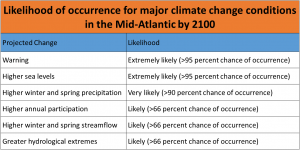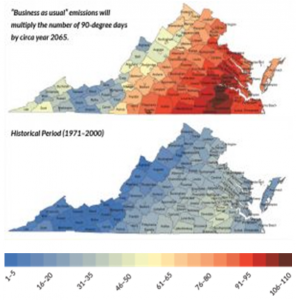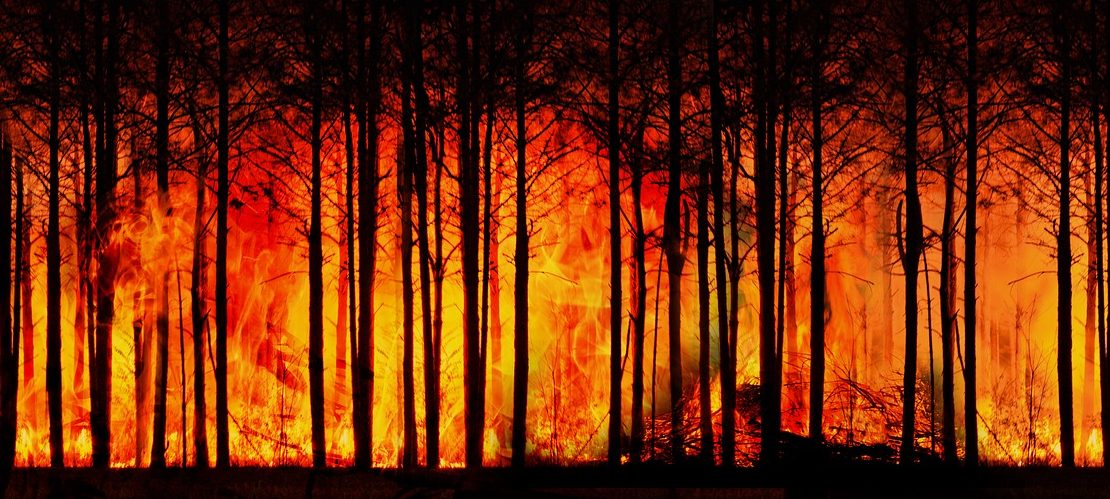Many scientists consider climate change to be the preeminent environmental issue of our time. Virginia faces multiple challenges from climate change that impact physical, ecological, economical, and cultural aspects of the entire state, especially coastal communities. Climate change effects in Virginia will likely include more extreme weather events (e.g., more droughts, more intense rainfall, and more intense storms and flooding), sea-level rise, and warmer temperatures. These changes are likely to magnify many of the coastal hazards we already face, and this is another good reason to be prepared with strategies and actions to increase the resilience of our homes and communities. This section provides an overview of climate change and regional climate trends and describes how these changes may exacerbate impacts of natural hazards.
Climate is the description of the overall, long-term pattern of weather in a specific area. Weather is typically measured over a period of days or weeks, while climate can be defined as the average weather for a particular region over a 20 to 30 year period [1]. When scientists talk about climate, they’re looking at averages of precipitation, temperature, humidity, sunshine, wind velocity, phenomena such as fog, frost, and hail storms, and other measures of the weather that occur over a long period in a particular place. Climate change refers to alterations in the long-term record of climate components (such as air temperature) sustained over a time period of several decades or longer [2]. Climate change is caused by a combination of natural influences and human activities. While Earth’s climate has experienced periods of natural changes over timeframes of hundreds and thousands of years, the large and rapid changes underway today are unprecedented and have never been recorded over Earth’s paleoclimatological record.
Climate change is affecting sea level, ocean chemistry, temperatures, length and timing of seasons, and the amount of annual rain and snowfall[3]. Many of these changes have negative consequences for people and the environment. Individuals and communities are working to reduce their risks from today’s climate hazards and tomorrow’s effects of climate change. There have been numerous documented changes in global climate conditions over the past century. To date, the world has seen increases in annual average temperatures, rates of sea-level rise, and altered precipitation patterns, as well as other trends such as increases in weather extremes, changes in the onset of seasons, and the melting of glaciers. Current global climate change trends are expected to continue into the future, and the rate of change for many of these variables is expected to increase.
 In general, the world is getting warmer, the oceans are getting warmer and more acidic, storms are getting more intense, and sea levels are rising at an accelerated rate. However, these general trends and their impacts vary by region. The table describes the likelihood of occurrence for major climate change conditions in the Mid-Atlantic by 2100.
In general, the world is getting warmer, the oceans are getting warmer and more acidic, storms are getting more intense, and sea levels are rising at an accelerated rate. However, these general trends and their impacts vary by region. The table describes the likelihood of occurrence for major climate change conditions in the Mid-Atlantic by 2100.
According to information recently synthesized by the U.S. Global Change Research Program, the Southeast region of the United States is exceptionally vulnerable to sea level rise, extreme heat events, hurricanes, and decreased water availability [4]. U.S. climate scientists report that the annual average temperature in the Southeast region (which includes the state of Virginia) has increased by an average of 2°F since 1970, with higher average temperatures during summer months. Warming has resulted in many other climate-related changes including more frequent very hot days and decreases in freezing events [6]. Increased days with temperatures exceeding 95F result in the formation of harmful air pollutants and allergens, a rise in hospital admissions due to respiratory illnesses, emergency room visits for asthma, and an above average number of deaths [7]. Increased temperatures also affect crop, livestock and dairy production [8]. While it cannot be proven with certainty, climatologists have predicted that the rate of sea-level rise occurring today will likely become greater in the decades to come [9].
 The maps show temperatures over the historical period from 1971 to 2000 alongside projected temperatures for the year 2065 if emissions continue at the current rate [11].
The maps show temperatures over the historical period from 1971 to 2000 alongside projected temperatures for the year 2065 if emissions continue at the current rate [11].
Virginia is vulnerable to climate change in several ways. We can expect to see warmer temperatures, more extreme weather events, rising sea levels, shorter winters and longer summers, and winters with less snowfall and more rainfall. Bridges and roads will be more susceptible to damage because of more severe storms and heavy rainfall, resulting in possible impacts to evacuation routes. Sea-level rise and increased storminess may threaten public and private property at the coast, with increased risk of flooding and loss of waterfront land. Increased flooding could also affect inland areas, structures, and facilities. Changing climate conditions such as temperature increases, altered precipitation patterns, and sea-level rise are projected to exacerbate impacts of natural hazards in Virginia. Some climate change impacts such as precipitation and heat waves will occur quickly in response to increasing temperatures. Others, such as sea-level rise, will continue on longer time scales from decades to hundreds of years. A general overview of potential impacts to coastal storms, floods, winter storms, drought, and other natural hazards is included below.
Coastal Storms
Coastal storms, which can lead to flooding, wind, and coastal erosion impacts, will be affected by climate change in several ways. Climate change may affect tropical system intensity, track, size, and/or rainfall. There is growing evidence that warming sea surfaces have resulted in the increased destructive potential of Atlantic tropical storms since 1970 [12]. The increasing intensity of tropical storms is likely to continue in the coming century as ocean waters continue to warm. It has also been found that major storm tracks have been moving northward and this has been attributed to changing climate [13]. It is important to note, however, that owing to difficulties in measuring tropical systems, separating the effects of human-influenced climate change from natural variability on hurricane activity is very difficult. At present, it remains uncertain whether past changes in hurricane activity have exceeded the trends and variability due to natural causes [14]. It is thought that rainfall intensity of storms is likely to increase, causing more riverine and creek flooding. Rising sea levels will exacerbate the negative effects of coastal storms including erosion and flooding. Although the exact destructive potential of storms depends on a given storm’s track, it can be said that the threat Virginia faces of future flooding, erosion, and wind impacts is greater than it is today.
Floods
With higher sea levels and more intense storms, the probability will increase for major coastal and inland flooding to occur. Coastal flooding will most directly increase due to sea-level rise and higher storm surge impacts. A rise in sea level will increase the extent of flood damage over time, with areas of lower elevation more susceptible to flooding. Inland flooding will increase due to the changing precipitation patterns (i.e., increased intensity of rainfall events) that are expected for the region. This type of flooding could also be directly affected by land-use decisions, as the amount of permeable surfaces affects rainfall’s infiltration potential. During heavy rain events, not only will some roads be impassable due to flooding, but after waters recede, more roads and culverts may need repair. Additionally, the increase in precipitation levels will change streamflow and sediment delivery, with the potential for scouring of bridge foundations [15].
Winter Storms
As the climate changes, winter precipitation is expected to become more episodic, with greater amounts of winter precipitation falling in more extreme events. Due to warmer temperatures, precipitation will fall more often as rain than snow or ice. This may result in Virginia seeing an increase in the occurrence of inland flooding during winter storm events.
Drought/Extreme Heat
Climate change is expected to increase the number and intensity of drought and extreme heat events. For instance, between 1971 and 2000, the area around and including Richmond averaged 36 days per year that were 90 degrees or higher, yet it is projected that this area will average 99 days per year over 90 degrees by the year 2065 if greenhouse gas emissions trends continue[16]. Drought can be caused by both a reduction of precipitation as well as by heat that causes increases in evaporation. Current climate change predictions for the region indicate that precipitation may become more irregular, thus reducing the amount of precipitation that reaches the groundwater system. Additionally, higher temperatures in the region will cause increases in evaporation. These interactions will likely increase the number of short-term droughts—those that last one to three months—making them occur as frequently as once per year [17].
Sea-Level Rise
Sea-level rise will not only increase flood heights, but will also change flood patterns in Virginia, causing current design flood events to occur more frequently. Additionally, sea-level rise will cause coastal flooding to reach farther landward. Structures, including homes, roads, and utilities that have been built in low-lying areas can become difficult to access, suffer structural instability, or become unusable. These changes in flood heights and patterns associated with rising sea levels can be applied across many different natural hazard events—coastal storms, severe thunderstorms, and winter storms—that can cause flooding. Sea-level rise will also cause certain dry areas in Virginia to become inundated, meaning that they will eventually become permanently wet. Other risks associated with sea-level rise include higher water tables and salt intrusion into aquifers. Additional effects of sea-level rise combined with increased frequency and intensity of storms include increased coastal erosion, impacts to coastal wetlands, and decreased effectiveness of existing coastal structures such as seawalls and revetments. Low-lying areas adjacent to these structures may be subject to increased flooding during storms.
With the climate changing and thus increasing the threats from natural hazards, Virginia is becoming increasingly vulnerable to many natural hazards. Communicating risks related to climate change and sea-level rise can be challenging due to scientific uncertainties and long time-frames associated with impacts; the scientific debate has also become politically polarized. Yet most everyone will acknowledge that there is no benefit in waiting to see if projected changes attributed to climate change will impact a specific region. Natural hazards are already taking a toll on individuals and communities, and it is not difficult to convince key stakeholders that specific hazard risks are real and present dangers. Given Virginia’s known natural hazard risks and the ever-increasing certainty of climate change impacts, there are a number of reasons for individuals and communities to proactively mitigate natural hazards and adapt to climate change. Because significant time is required to motivate, develop adaptive capacity, and implement changes, acting now will allow for the time needed to achieve these long-term goals. Additionally, many hazard mitigation measures and adaptation strategies that address existing problems, such as short-term impacts of coastal storms, also provide benefits that help in preparing and planning for long-term effects of sea-level rise.
So what can you do to protect your family, your property, and your community? The most important actions you can take are participating in mitigation and adaptation. Mitigation includes actions taken to eliminate or reduce the causes and sources of climate change. Mitigation is most effectively done by reducing carbon dioxide (CO2 ) emissions. CO2 is one of several greenhouse gases that contribute to global warming and climate change. The United States is second only to China in terms of CO2 emissions (Source: Washington State Department of Ecology). Making a few small changes in your home and yard can reduce greenhouse gases and save you money. Some simple steps include:
- Replacing light bulbs with CFL or LED lights
- Purchasing Energy Star products
- Using a programmable thermostat
- Insulating your home
- Using water efficiently
- Using Florida Friendly landscaping principles
- Practicing reduce, reuse and recycle
When away from home, you can take additional steps to limiting your carbon footprint including:
- Carpooling, walking, biking or utilizing public transportation when possible
- Combining trips for errands
- Maintaining correct tire pressure in your vehicle
- Following your car’s maintenance schedule
Another major reason to begin enhancing hazard mitigation efforts with climate change adaptation is that proactive planning is often more effective and less costly than reactive planning and can provide immediate benefits. In fact, many climate adaptation actions appropriate for long-term planning are identical to those employed to manage or mitigate severe and more immediate impacts of other hazards. Examples include floodplain management plans, beach and dune management strategies, and higher floor elevation requirements to mitigate flood hazards. Integration of hazard mitigation planning (with its focus on past events) with climate change adaptation (and its attention to what might happen in the future) results in a win-win, no-regrets strategy that will prepare individuals and communities for future risk, no matter what the cause.
Home | Introduction | Overview of Natural Hazards | Protecting Yourself and Your Family | Protecting Your Property | Insurance | Coastal Construction and Beach Management | Climate Change
Additional resources: Learn More | Useful Tools | Get Connected
- Glossary of Climate Change Terms. U.S. EPA Climate Change website. Accessed August 2012 at epa.gov/climatechange/glossary.html.
- Glossary of Meteorology, 2nd Edition. T. S. Glickman. American Society of Meteorology, Chicago, Illinois: University of Chicago Press, 2000.
- Global Climate Change Impacts in the United States. U.S. Global Climate Change Research Program, 2009. Accessed August 2012 at globalchange.gov.
- Southeast. U.S. Global Climate Research Program, 2014. Accessed July 2016 at http://nca2014.globalchange.gov/highlights/regions/southeast.
- Climate Change, Global Warming and Ocean Levels. The State of the Region, 2009. Accessed July 2016 at https://www.odu.edu/content/dam/odu/offices/economic-forecasting-project/docs/2009_sor_ch5.pdf.
- Southeast. U.S. Global Climate Research Program, 2014. Accessed July 2016 at http://nca2014.globalchange.gov/highlights/regions/southeast.
- Southeast. U.S. Global Climate Research Program, 2014. Accessed July 2016 at http://nca2014.globalchange.gov/highlights/regions/southeast.
- Southeast. U.S. Global Climate Research Program, 2014. Accessed July 2016 at http://nca2014.globalchange.gov/highlights/regions/southeast.
- Global Climate Projections. Chapter 10 in Climate Change 2007: Working Group I: The Physical Science Basis by the Intergovernmental Panel on Climate Change (IPCC), 2007. Available online at ipcc.ch/publications_and_data/publications_and_data.shtml.
- Climate Change and Uncertainty in the Mid-Atlantic Region. R. G. Najjar. Coastal Habitat Conservation in a Changing Climate: Strategies and Tools in the Mid-Atlantic Region. Wilmington, Del., 2012. Accessed September 2014 at collaborate.csc.noaa.gov/ climateadaptation/Coastal%20Habitat%20Conservation/Workshop%20Presentations/ Najjar_MidAtlanticCC_Jun21.pdf.
- Local Data. Steven Nash. Virginia Climate Fever, 2000. Accessed July 2016 at http://virginiaclimatefever.com/5-2/localdata/
- Comprehensive Assessment of Climate Change Impacts in Maryland. Report to the Maryland Commission on Climate Change Chapter 2, D. F. Boesch, and J. M. Hawkey, (eds.), 2008. Available online at mde.maryland.gov/programs/air/climatechange/documents/final-chapt%202%20impacts_web.pdf.
- A Consistent Poleward Shift of the Storm Tracks in Simulations of 21stCentury Climate.Jeffrey Yin, 2005. Accessed July 2016 at http://www-k12.atmos.washington.edu/~salathe/papers/Yin2005.pdf.
- Projections of Future Tropical Cyclone Activity. I. Ginis. University of Rhode Island Climate Change Science Symposium, May 5, 2011. Accessed June 2016.
- Potential Impacts of Climate Change on U.S. Transportation: Special Report 290. 2008. National Research Council, Committee on Climate Change and U.S. Transportation. The National Academies Press, Washington D. C., 2008.
- Local Data. Steven Nash. Virginia Climate Fever, 2000. Accessed July 2016 at http://virginiaclimatefever.com/5-2/localdata/
- Northeast Climate Impacts Assessment Report. Climate Change in the U.S. Northeast, 2006/ Available online at climatechoices.org/assets/documents/climatechoices/NECIA_Climate_report_final



